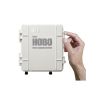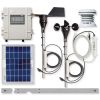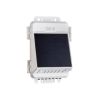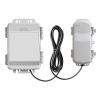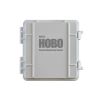HOBO USB Micro Station
Features
- Weatherproof IP66 enclosure for harsh environments
- Direct USB offload using CABLE-USBMB
- Includes five smart sensor inputs
- Free ground shipping
- Expedited repair and warranty service
- Lifetime technical support
- More
Overview
The Onset HOBO USB Micro Station is a weatherproof data logger for multi-channel monitoring of microclimates. This battery-powered station accepts up to five plug-and-play Smart Sensors (sold separately) and has a hinged door to make sensor installation simple and quick.
Compatibility
The Micro Station is equipped with a built-in USB port for fast, efficient data readout to a computer, and integrated mounting tabs for easy installation using the USB cable (sold separately). Hoboware software is also required for configuration and readout.
Note: that the H21-USB is not compatible with macOS 13 and 14
| Operating Range | -20° to 50°C (-4° to 122°F) with alkaline batteries -40 to 70°C (-40 to 158°F) with lithium batteries |
Smart Sensor Connectors |
5 |
| Smart Sensor Data Channels | Maximum of 15 (some smart sensors use more than one data channel; see sensor manual for details) |
Smart Sensor Network Cable Length |
100 m (328 ft) maximum |
Logging Interval |
1 second to 18 hours |
Start Modes |
Immediate, at interval, push button, or delayed start |
Memory Modes |
Stop when full or wrap when full |
Memory |
512 KB nonvolatile flash data storage |
Time Accuracy |
0 to 2 seconds for the first data point and ±5 seconds per week at 25°C (77°F) |
Battery Type |
Four AA 1.5 V alkaline batteries for operating conditions of -20° to 50°C (-4° to 122°F); four AA 1.5 V lithium batteries for operating conditions of -40 to 70°C (-40 to 158°F) |
Battery Life |
1 year, typical use (up to five sensors with 1 minute or greater logging interval) |
Communication Type |
USB 2.0 interface |
Full Memory Download Time |
4 minutes |
Enclosure Access |
Hinged door secured by one latch with eyelet for use with user-supplied padlock |
Materials |
Outer enclosure: Polycarbonate/PBT blend with stainless steel hinge pins; Gaskets: Silicone rubber; Cable channel: EPDM rubber |
Dimensions |
17.04 x 11.94 x 4.47 cm (6.71 x 4.70 x 1.76 in.) see diagrams in manual Padlock hole diameter: 0.58 cm (0.23 in.) |
Weight |
414g (14.6 oz.) |
Environmental Rating |
Weatherproof enclosure, NEMA 4X and IP66 |
- HOBO H21-USB Micro Station
- Four AA 1.5V alkaline batteries
- Rubber plugs
- Grease packet
- Screws and washers
- Cable ties
In The News
Wave-Powered Buoy Deployed in Puget Sound
While the development of solar-powered monitoring systems has improved access to real-time environmental data, solar power is still limited by low light conditions, such as poor weather, nighttime, or high-latitude environments. To supplement these incumbent power solutions at sea, Ocean Motion Technologies has developed a small-scale ocean wave energy system that can be directly integrated with existing data buoy platforms. Not only does wave energy supplement solar power during periods when the buoys are limited by light availability, but it also allows data buoys to perform beyond their current power capacities.
Read MoreLong-Term Monitoring in the Chautauqua Lake Watershed
With a widely developed shoreline, Chautauqua Lake experiences influxes of non-point source pollution that have historically impacted the health of the lake. The Chautauqua Lake Association (CLA) has been monitoring the lake for over two decades, reporting on changes that have occurred over the years. A pair of local lake advocates, Jane and Doug Conroe, have lived on the lake for over 40 years and have played an important role in establishing monitoring programs and facilitating consistent data collection throughout the watershed. Doug has been involved with the Chautauqua Lake Association (CLA) since the pair moved to the area in 1980, and is currently serving as the Executive Director.
Read MoreNo Red Herrings: Data Driving the Largest Salt Marsh Restoration in the NE USA
The Herring River system encompasses around 1,000 acres in the Towns of Wellfleet and Truro, Massachusetts. In 1909, the Chequessett Neck Road dike was built at the river’s mouth, drastically limiting tidal flow. Today, it’s one of the most restricted estuaries in the northeastern United States. As a result, the area has suffered environmental decline, including poor water quality, hypoxia, lower pH, and salt marsh degradation. In 2023, the Town of Wellfleet received $14.7 million from NOAA’s Office of Habitat Conservation to fund the Herring River Restoration Project (HRRP). Francesco Peri, President and CEO at Charybdis Group LLC, uses a network of NexSens data loggers to monitor water level and water quality on the Herring River.
Read More








































